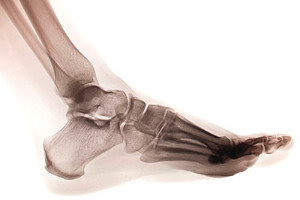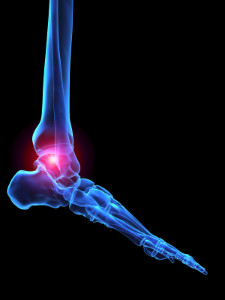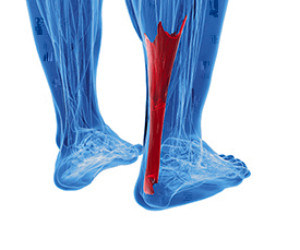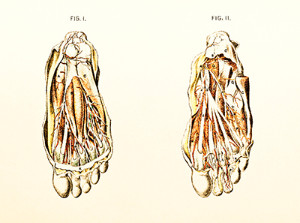 Stress fractures are typically what is known as an “overuse injury”. It commonly happens in response to a heavy workload placed on the bone. Over time, a buildup of calcium occurs around the bone when it’s overused. If the bone is not able to repair itself while not undergoing stress, tiny cracks may form, resulting in what is know as a stress fracture. It typically occurs in the foot, leg and pelvis. Some symptoms can include pain and swelling. Because it’s more common for women to develop osteoporosis, they’re much more likely to obtain a stress fracture. When the lower part of the body is overused, the bones of the feet are at great risk for stress fractures.
Stress fractures are typically what is known as an “overuse injury”. It commonly happens in response to a heavy workload placed on the bone. Over time, a buildup of calcium occurs around the bone when it’s overused. If the bone is not able to repair itself while not undergoing stress, tiny cracks may form, resulting in what is know as a stress fracture. It typically occurs in the foot, leg and pelvis. Some symptoms can include pain and swelling. Because it’s more common for women to develop osteoporosis, they’re much more likely to obtain a stress fracture. When the lower part of the body is overused, the bones of the feet are at great risk for stress fractures.
Activities where too much pressure is put on the feet can cause stress fractures. To learn more, contact Dr. Lubrina Bryant from District Podiatry, PLLC. Our doctor can provide the care you need to keep your pain free and on your feet.
Dealing with Stress Fractures of the Foot and Ankle
Stress fractures occur in the foot and ankle when muscles in these areas weaken from too much or too little use. The feet and ankles then lose support when walking or running from the impact of the ground. Since there is no protection, the bones receive the full impact of each step. Stress on the feet can cause cracks to form in the bones, thus creating stress fractures.
What Are Stress Fractures?
Stress fractures occur frequently in individuals whose daily activities cause great impact on the feet and ankles. Stress factors are most common among:
Symptoms
Pain from the fractures occur in the area of the fractures and can be constant or intermittent. It will often cause sharp or dull pain with swelling and tenderness. Engaging in any kind of activity which involves high impact will aggravate pain.
If you have any questions please feel free to contact our office located in Washington, D.C . We offer the newest diagnostic and treatment technologies for all your foot and ankle needs.
 Rheumatoid arthritis is a disorder and form of arthritis in which the body’s immune system attacks the lining of the joints. This can cause pain and inflammation and over time can damage the joints and bone. Rheumatoid arthritis can occur in any joint in the body but often occurs in the hands, wrists, and feet. Symptoms include pain, stiffness, and inflammation. Other symptoms can include fatigue, numbness, fever, sweating, and weight loss. These symptoms can often come and go and can last for days or weeks. There is currently no cure for rheumatoid arthritis; however seeing a doctor, such as a podiatrist, if you are experiencing pain in your feet can help provide a diagnosis and treatment. Treatment options may include therapy, medication, and, in some cases, surgery.
Rheumatoid arthritis is a disorder and form of arthritis in which the body’s immune system attacks the lining of the joints. This can cause pain and inflammation and over time can damage the joints and bone. Rheumatoid arthritis can occur in any joint in the body but often occurs in the hands, wrists, and feet. Symptoms include pain, stiffness, and inflammation. Other symptoms can include fatigue, numbness, fever, sweating, and weight loss. These symptoms can often come and go and can last for days or weeks. There is currently no cure for rheumatoid arthritis; however seeing a doctor, such as a podiatrist, if you are experiencing pain in your feet can help provide a diagnosis and treatment. Treatment options may include therapy, medication, and, in some cases, surgery.
Because RA affects more than just your joints, including the joints in your feet and ankles, it is important to seek early diagnosis from your podiatrist if you feel like the pain in your feet might be caused by RA. For more information, contact Dr. Lubrina Bryant of District Podiatry, PLLC. Our doctor will assist you with all of your podiatric concerns.
What Is Rheumatoid Arthritis?
Rheumatoid Arthritis (RA) is an autoimmune disorder in which the body’s own immune system attacks the membranes surrounding the joints. Inflammation of the lining and eventually the destruction of the joint’s cartilage and bone occur, causing severe pain and immobility.
Rheumatoid Arthritis of the Feet
Although RA usually attacks multiple bones and joints throughout the entire body, almost 90 percent of cases result in pain in the foot or ankle area.
Symptoms
Diagnosis
Quick diagnosis of RA in the feet is important so that the podiatrist can treat the area effectively. Your doctor will ask you about your medical history, occupation, and lifestyle to determine the origin of the condition. Rheumatoid Factor tests help to determine if someone is affected by the disease.
If you have any questions please feel free to contact our office located in Washington, D.C . We offer the newest diagnostic and treatment technologies for all your foot and ankle needs.
 Basketball player Sheldon Mac of the Wizards has recently torn his left Achilles tendon and will need to undergo surgery to repair it. He will very likely be out for the rest of the season. His recovery timetable is around six to eight months. If there is any good news for Mac, it's that his contract guarantees him 1.3 million dollars. Of course, that doesn't really give much solace to the fans.
Basketball player Sheldon Mac of the Wizards has recently torn his left Achilles tendon and will need to undergo surgery to repair it. He will very likely be out for the rest of the season. His recovery timetable is around six to eight months. If there is any good news for Mac, it's that his contract guarantees him 1.3 million dollars. Of course, that doesn't really give much solace to the fans.
Achilles tendon injuries need immediate attention to avoid future complications. If you have any concerns, contact Dr. Lubrina Bryant of District Podiatry, PLLC. Our doctor can provide the care you need to keep you pain-free and on your feet.
What Is the Achilles Tendon?
The Achilles tendon is a tendon that connects the lower leg muscles and calf to the heel of the foot. It is the strongest tendon in the human body and is essential for making movement possible. Because this tendon is such an integral part of the body, any injuries to it can create immense difficulties and should immediately be presented to a doctor.
What Are the Symptoms of an Achilles Tendon Injury?
There are various types of injuries that can affect the Achilles tendon. The two most common injuries are Achilles tendinitis and ruptures of the tendon.
Achilles Tendinitis Symptoms
Rupture Symptoms
Treatment and Prevention
Achilles tendon injuries are diagnosed by a thorough physical evaluation, which can include an MRI. Treatment involves rest, physical therapy, and in some cases, surgery. However, various preventative measures can be taken to avoid these injuries, such as:
If you have any questions please feel free to contact our office located in Washington, D.C . We offer the newest diagnostic tools and technology to treat your foot and ankle needs.
 Have your feet ever felt numb while you were working out? If so, then you may have experienced paresthesia, a numbness or prickling sensation that many people have temporarily experienced in their life. It is often described as a “pins and needles” sensation that usually goes away once the position of the body changes. Paresthesia is usually caused by a pinched nerve or reduced blood flow to a part of the body. When it comes to working out, the exercises we do can put our body in positions that may reduce blood flow. In other cases, the muscles can swell due to increased blood flow from exercising. Paresthesia is usually a normal condition and often goes away. Not everyone will experience paresthesia or foot swelling, and in most cases it isn’t serious. If, however, your feet have swollen up, feel numb, or you experience pain that doesn’t go away, it is recommended to see a podiatrist.
Have your feet ever felt numb while you were working out? If so, then you may have experienced paresthesia, a numbness or prickling sensation that many people have temporarily experienced in their life. It is often described as a “pins and needles” sensation that usually goes away once the position of the body changes. Paresthesia is usually caused by a pinched nerve or reduced blood flow to a part of the body. When it comes to working out, the exercises we do can put our body in positions that may reduce blood flow. In other cases, the muscles can swell due to increased blood flow from exercising. Paresthesia is usually a normal condition and often goes away. Not everyone will experience paresthesia or foot swelling, and in most cases it isn’t serious. If, however, your feet have swollen up, feel numb, or you experience pain that doesn’t go away, it is recommended to see a podiatrist.
Poor circulation is a serious condition and needs immediate medical attention. If you have any concerns with poor circulation in your feet contact Dr. Lubrina Bryant of District Podiatry, PLLC. Our doctor will treat your foot and ankle needs.
Poor Circulation in the Feet
Poor blood circulation in the feet and legs is can be caused by peripheral artery disease (PAD), which is the result of a buildup of plaque in the arteries.
Plaque buildup or atherosclerosis results from excess calcium and cholesterol in the bloodstream. This can restrict the amount of blood which can flow through the arteries. Poor blood circulation in the feet and legs are sometimes caused by inflammation in the blood vessels, known as vasculitis.
Causes
Lack of oxygen and oxygen from poor blood circulation restricts muscle growth and development. It can also cause:
Those who have diabetes or smoke are at greatest risk for poor circulation, as are those who are over 50. If you have poor circulation in the feet and legs it may be caused by PAD and is important to make changes to your lifestyle in order to reduce risk of getting a heart attack or stroke. Exercise and maintaining a healthy lifestyle will dramatically improve conditions.
As always, see a podiatrist as he or she will assist in finding a regimen that suits you. A podiatrist can also prescribe you any needed medication.
If you have any questions please feel free to contact our office located in Washington, D.C . We offer the newest diagnostic and treatment technologies for all your foot and ankle needs.
 Tarsal tunnel syndrome is a condition in which the posterior tibial nerve in the tarsal tunnel becomes pinched or compressed. This causes a number of symptoms including burning and shooting pain, a pins and needles sensation, numbness, and tightness in the foot. There are several reasons why the nerve could become compressed, which include bony prominences, bone spurs, abnormal heel position, and the swelling of tendons in the tarsal tunnel. Due to the nature of tarsal tunnel syndrome, diagnosis may be difficult because it can seem to mimic the symptoms of other conditions; heel pain and arch pain are some examples. It is best to see a podiatrist if you are experiencing any of those symptoms. Podiatrists can offer a number of treatments, such as orthotics, taping or bracing, rest, icing, anti-inflammatory medication, or even surgery if other treatments do not improve your condition.
Tarsal tunnel syndrome is a condition in which the posterior tibial nerve in the tarsal tunnel becomes pinched or compressed. This causes a number of symptoms including burning and shooting pain, a pins and needles sensation, numbness, and tightness in the foot. There are several reasons why the nerve could become compressed, which include bony prominences, bone spurs, abnormal heel position, and the swelling of tendons in the tarsal tunnel. Due to the nature of tarsal tunnel syndrome, diagnosis may be difficult because it can seem to mimic the symptoms of other conditions; heel pain and arch pain are some examples. It is best to see a podiatrist if you are experiencing any of those symptoms. Podiatrists can offer a number of treatments, such as orthotics, taping or bracing, rest, icing, anti-inflammatory medication, or even surgery if other treatments do not improve your condition.
Tarsal tunnel syndrome can be very uncomfortable to live with. If you are experiencing tarsal tunnel syndrome, contact Dr. Lubrina Bryant of District Podiatry, PLLC. Our doctor can provide the care you need to keep you pain-free and on your feet.
Tarsal Tunnel Syndrome
Tarsal tunnel syndrome, which can also be called tibial nerve dysfunction, is an uncommon condition of misfiring peripheral nerves in the foot. The tibial nerve is the peripheral nerve in the leg responsible for sensation and movement of the foot and calf muscles. In tarsal tunnel syndrome, the tibial nerve is damaged, causing problems with movement and feeling in the foot of the affected leg.
Common Cause of Tarsal Tunnel Syndrome
The Effects of Tarsal Tunnel Syndrome
A physical exam of the leg can help identify the presence of tarsal tunnel syndrome. Medical tests, such as a nerve biopsy, are also used to diagnose the condition. Patients may receive physical therapy and prescriptive medication. In extreme cases, some may require surgery.
If you have any questions please feel free to contact our office located in Washington, D.C . We offer the newest diagnostic and treatment technologies for all your foot and ankle needs.